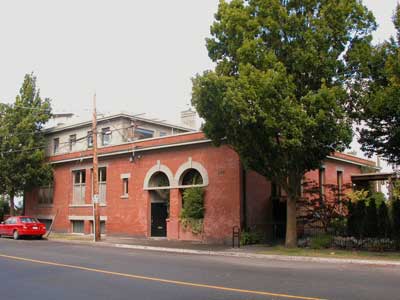ARCHITECTURE:
This plain red brick, one-storey, flat-roofed institutional building has a heavy rolled metal cornice. The original double-arched entrance is no longer used, a covered entrance is now on the east side. The window headers, sills and twin arches of the original entrance are of sandstone. In 1944 a partial second storey was added. In 1977 the building became a Unitarian church, in 1993, a private residence and antique shop. The building opened as a restaurant in 2005.
ORIGINAL OCCUPANTS:
The Connaught Seamen’s Institute was built in 1914, during a period of steady growth of maritime trade, partly due to the booming BC lumber industry and the opening of the Panama Canal that year. The Institute demonstrates the continuing efforts, begun with the creation of school, park and church reserves in the 1850s, of Victoria citizens to replicate the infrastructure of the standard British colonial port. The function of the Institute, to provide safe overnight accommodation for seafarers far from home in a nurturing Anglican environment, reminds us of the darker side of port life, and the negative effects of drink and loneliness that the church sought to address. The association of the Institute in its early years with prominent, mainly female, citizens including Lady Douglas and the Dunsmuirs, speaks to the strong temperance movement and the significance of women’s influence generally in Victoria’s history.
The choice of John Charles Malcolm Keith as the architect for the Institute reflects his strong Anglican leanings, and his interest in architectural commissions that included schools, parish churches and Victoria’s Anglican Cathedral (908-912 Vancouver St / 911 Quadra St, Fairfield ).
There is a cornerstone that reads “This stone was laid September 28, 1912 by H.R.H. the Duke of Connaught K.C. Governor General of Canada. J.C.M. Keith Architect” and a stone plaque that reads “Seamen’s Institute. Come unto me all Ye that are weary and I will give you rest.”
OTHER OCCUPANTS:
No longer a seamen’s institute, the surviving building reminds us of the busy port that Victoria once was. In 1977 the building became a Unitarian church, in 1993, a private residence and antique shop. The building opened as a restaurant in 2005.

